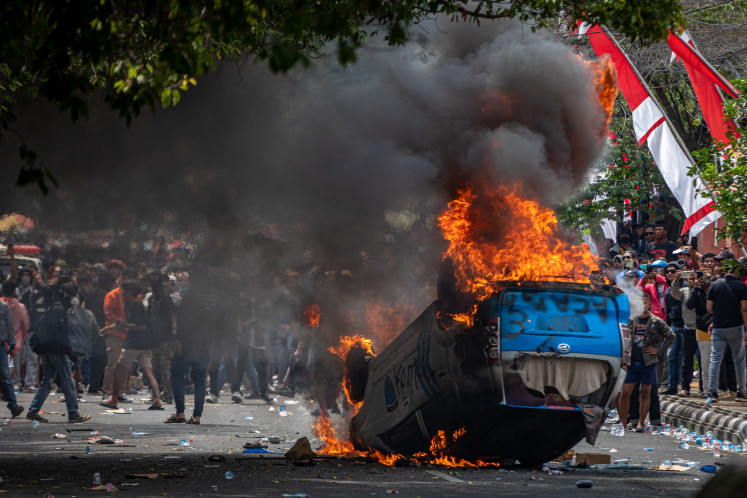Popular Reads
Top Results
Can't find what you're looking for?
View all search resultsPopular Reads
Top Results
Can't find what you're looking for?
View all search resultsAfter drought and smoke, RI to get wetter rainy season
This year, Indonesia is likely to have 70 percent more rain than normal due to the climate phenomenon known as La Niña, according to the US National Oceanic And Atmospheric Administration (NOAA)
Change text size
Gift Premium Articles
to Anyone
T
his year, Indonesia is likely to have 70 percent more rain than normal due to the climate phenomenon known as La Niña, according to the US National Oceanic And Atmospheric Administration (NOAA).
NOAA determined the weather trend with its global tropical moored buoy array, which spans the Atlantic, Indian and Pacific oceans.
The buoys, named the Research Moored Array for African-Asian-Australian Monsoon Analysis and Prediction (RAMA), are used to study the correlation of maritime data and climate change.
After the 2006 signing of a memorandum of understanding between NOAA, the Maritime Affairs and Fisheries Ministry and the Agency for the Assessment and Application of Technology (BPPT), Indonesia has actively participated in the global oceanic observing system in the Indian Ocean.
Since 2007, Indonesia has set up and maintained six buoys with the Baruna Jaya research vessel. Other Indian Ocean countries including India, Sri Lanka and the Maldives also contributed to setting up and taking care of the buoys. Of the 46 buoys planned for the Indian Ocean, 30 have been set up.
Michael J. McPhaden, NOAA’s senior research scientist, said that since the maritime data recorded by the buoys could help predict general climate anomalies for the next nine months, they could deduce that La Niña would return this year.
“There will be more rainfall until March 2012, with rain precipitation likely to be above normal, so Indonesians should prepare for flooding,” he said.
La Niña is associated with cooler than normal water temperatures in the Equatorial Pacific Ocean, unlike El Niño which is associated with warmer water.
BPPT ocean engineer Wahyu W. Pandoe said that oceanographers and climatologists watched the ocean to learn the relationship between maritime data and climate change. He said the correlation of changes in temperature, density, salinity and several other parameters could signal climate change and indicate El Niño or La Niña in the months ahead.
“Data from the buoys is received in almost real time and later processed to predict the climate,” he said.
NOAA started the buoy project after the 1982–1983 El Niño, which was considered the strongest El Niño in the 20th century. At that time, there was no forecasting model to predict the climate.
“With the buoys, we can observe evolving oceanic and atmospheric conditions in the tropics in real time, predict both El Niños and La Niñas and advance our understanding of the climate system,” McPhaden said.
He added that the trends indicated that La Niña usually came in two consecutive years, while El Niño only happened one year at a time. He added that in the past 30 years, there were more El Niños than La Niñas, but records from the last 10 years showed a balance.
“Our concern is that we will have stronger El Niño with the rise of global warming, but it is a speculation; we need to conduct more study about it,” he said.
Until early last week, regions in Indonesia suffered severe impacts from the drought caused by the dry weather since July. The drought has made it difficult for people in several regions to find clean water for drinking, cooking and bathing because their water reservoirs had dried.
The long dry season has also triggered forest fires in Sumatra and Kalimantan, sending heavy smoke to Singapore and Malaysia.
In Bali, locals queue at water sources that have started to dry, including rivers. In Gunungkidul, Yogyakarta, students and teachers prayed for rain as the region struggled to cope with the prolonged drought.










